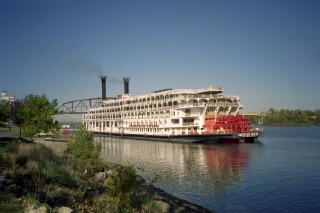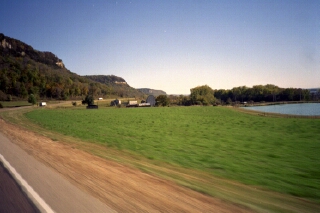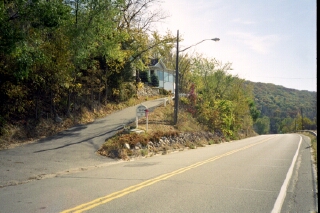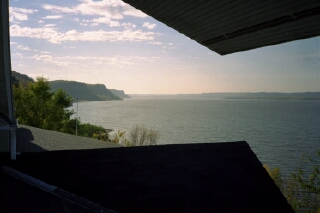Fall Tour 2000
Day 3: Wabasha to Maiden Rock WI
Back to Day 1
Back to Day 2
Day Three saw us exploring Wabasha on foot. Wabasha is yet another
river town, that being implicit to the theme of the tour. Unlike
Hastings, Red Wing and Lake City, Wabasha seems a bit down at the
heels. There are a lot of boarded up storefronts on the main street.
After wondering about this for a while, we realized that it is because
the highways go around rather than through Wabasha. Hwy 61 is on the
main street of the other three towns, but it is about a mile and a
half west of downtown Wabasha. I suppose that this has two sides to
the coin. On one hand, the economy suffers but on the other hand the
town isn't constantly invaded with traffic and tourists. However,
"Grumpy Old Men" seems to have produced some economic benefits for
Wabasha, as should the opening of the National Eagle Center.
 Wabasha, on the other hand, does have riverboats. The
Mississippi is still plied by large luxury boats, stern-wheelers
recreating (and improving on) the opulence and luxury of
turn-of-the-century travel. The Delta Queen, the Mississippi Queen,
the American Queen all carry passengers up and down the river. They
look like baroque floating hotels and the sheer size of them is quite
impressive. The American Queen came to Wabasha as we were preparing
to leave, so we walked the few blocks to the quay to check it out.
Wabasha, on the other hand, does have riverboats. The
Mississippi is still plied by large luxury boats, stern-wheelers
recreating (and improving on) the opulence and luxury of
turn-of-the-century travel. The Delta Queen, the Mississippi Queen,
the American Queen all carry passengers up and down the river. They
look like baroque floating hotels and the sheer size of them is quite
impressive. The American Queen came to Wabasha as we were preparing
to leave, so we walked the few blocks to the quay to check it out.
I tend to be a little jaded and try to be hard to impress when it
comes to tourist type stuff, but I was impressed by this boat. It was
a floating building, a huge and grandiloquent homage to the river's
past, the River as idealized by Mark Twain and John Hartford. The
stern wheel was huge, and I doubt that the pictures really convey the
scale of the thing.
We spent a little time walking along the river in Wabasha. I have
lived by the Mississippi River since 1977, usually no more than a mile
or two away and sometimes only blocks away. I've spent many hours
sitting on its banks, watching the water flow by. It's an amazing
thing, really more of a long narrow freshwater ocean than a river.
The river has moods and tempers which can be felt, especially near the
locks and dams where you can feel it pushing against the concrete and
steel. In the backwaters it is quiet and gentle, in the summer
feeling like the bayous and in the winter like the sub-arctic. Life
teems in the river, with schools of fish, flocks of birds and numerous
animals large and small living along its banks. From a canoe you can
see eagles swooping down to nab fish, or great blue herons stalking
them with catlike grace. Huge northern pike swim by just under the
surface, ancient sturgeon live there and catfish hunker down along the
bottom.
Almost every bike ride I take from my house brings me into sight of
the Mississippi and Minnesota Rivers, which merge just a few miles
from my home. The river casts a spell on the whole area of
southeastern Minnesota and western Wisconsin. In fact, the river
still defines human life in the area in much the same way as it has
for thousands of years. The very name "Mississippi" is a
mispronunciation of the native word for "Father of Waters." Live
within a mile of it for a while, and it grabs you too.
About 16 or 17 years ago, the Mississippi River Revival was started
by Larry Long, inspired by
Pete Seeger's movement to rehabilitate the Hudson River and make it
clean again. The MMR got volunteers, who went out in canoes and
hauled in garbage. Thousands of pounds of steel, aluminum, wood,
glass, appliances, motor vehicles, 55 gallon drums, plastic,
Styrofoam... hundreds of cubic yards of rubbish taken back out of the
water, recycled where possible and disposed of properly where not
recyclable. It was hugely satisfying to fill a semi-trailer sized
dumpster with reclaimed garbage. It took years, with multiple
locations up and down the river in St. Paul, Minneapolis, Winona,
LaCrosse, Iowa. This was paired with legal action by Citizens for a Better Environment in
Minnesota and Wisconsin to force the separation of storm and sanitary
sewers to reduce pollution, to prosecute industrial polluters, to halt
agricultural runoff into the river.
Many of America's rivers are cleaner than they have been in 50
years thanks to efforts like these. There's a long way to go,
however, and there are signs not a mile from my house warning pregnant
women not to eat fish taken out of the river. It's a truly sad thing
that we cannot share in the bounty of the earth and its waters because
of pollution. Ironically, hunting and fishing were declared
"Constitutional rights" in Minnesota a couple of years ago, and yet we
cannot safely partake of those rights on the Mississippi River. What
good is freedom if there is not clean air and pure water? We are not
free so long as our human rights are subordinate to corporate greed
and carelessness. More information is available on the Minnesota River Basin Alliance Web
site.
From Wabasha, it was time to cross the Mississippi River and travel
into Wisconsin. In my life I have lived in three states- Illinois,
Wisconsin and Minnesota. I don't know exactly why, but I can tell
which state I am in by looking at the roads. There is something
unique about the roads in each state and they all look different from
each other. I'm not even sure that I can describe the differences.
Wisconsin seems to be a generally friendly place to ride a bike, which
is not always true in Minnesota and certainly not true in much of
Illinois. However, today we were again driving in a blue and white
1972 Volkswagen bus with the bikes in the back.
 Across the river from Wabasha is Nelson WI. We stopped at the
Nelson Cheese Factory- Wisconsin is, after all, the Dairy State. Says
so on their license plates. I had last been to the Nelson Cheese
Factory about 15 years ago or more, at which time the sales room was
about 10 feet by 10 feet with one cooler full of cheese. Since then,
the sales area has expanded as have the varieties of cheese and other
things on sale. We were able to buy a nice selection of cheeses,
breads and meats for a light lunch with excellent ice cream for
desert. Not perhaps the ideal bicycling diet, but awfully good none
the less. We sat out on their patio enjoying the sun, the weather
again being particularly fine with a gentle breeze.
Across the river from Wabasha is Nelson WI. We stopped at the
Nelson Cheese Factory- Wisconsin is, after all, the Dairy State. Says
so on their license plates. I had last been to the Nelson Cheese
Factory about 15 years ago or more, at which time the sales room was
about 10 feet by 10 feet with one cooler full of cheese. Since then,
the sales area has expanded as have the varieties of cheese and other
things on sale. We were able to buy a nice selection of cheeses,
breads and meats for a light lunch with excellent ice cream for
desert. Not perhaps the ideal bicycling diet, but awfully good none
the less. We sat out on their patio enjoying the sun, the weather
again being particularly fine with a gentle breeze.
A few miles south of Nelson on Highway 35, part of the Great River
Road system, is Alma. Alma is visible for miles and miles up and down
the river because of two big towers belonging to the power plant
there. Most of the river towns on the Wisconsin side are quite a bit
smaller than their Minnesota counterparts, and seem to have preserved
their unique charm better. Alma is like this, a town two blocks wide
and three or four miles long.
Above the town on the bluff is Buena Vista Park. I went there with
some other people from my dorm 23 years ago and wanted to go back. It
was a long and chugging climb for the bus, but geared down it went
fine. Along the top of the ridge we followed the signs, but it looked
for all the world like we were just going to end up in some farmer's
yard, disrupting their lives. However, the signs didn't lie. We
pulled into the huge parking lot and saw only a couple of cars. The
park is small, with a flagstone path leading to the overlook. 
The overlook is exquisite, 400 feet or so above the river and with
at least 10 miles of visibility either up or down river. Thanks to
this being Wisconsin, there was no guard rail at the edge of the cliff
to spoil the view, and we could sit on a slab of limestone and look
out at a scene only slightly different from what would have been seen
thousands of years ago. The city of Alma and the lock and dam looked
puny compared to the river, and the river will probably outlast the
works of humans. We sat there for nearly an hour, enjoying the
October sun. There were just a few other people there, some of whom
asked us to take pictures of them with their cameras. I felt a little
foolish, because for some reason point-and-shoot cameras baffle me. I
find it easier to use cameras that require me to set the f-stop and
shutter speed. You'd think that just pushing a button would be easy,
but I always have to have people explain their cameras to me before I
can take a picture.
(As a complete aside, all of the photos taken for this story were
made with an Olympus XA compact 35mm camera, with a detachable flash.
Without the flash, it is about the size of a pack of cigarettes and
fits readily into a jersey pocket or the pocket of my Carradice
saddlebag. I first saw one of these in 1981 in the hands of a
professional photographer, who always carried his just in case he saw
something worth shooting. The only problem I have had is that the
small size sometimes results in one of my fingers partially blocking
the lens. Doh! All the photos on these pages, except for the one of
the Anderson House, were shot on Kodak Gold 200 print film, and
processed by Proex who also made Kodak photo CDs for easy uploading
into the Web server. What a slick system!)
We drove back down the curvy road from the park into Alma. Had I
been thinking I would have gotten my bike out for a free downhill
ride. Alas, I wasn't paying attention! We went north on Wisconsin
Hwy 35 back through Nelson and north to Pepin and Stockholm,
respectively. In Pepin is the Harborview Cafe, a highly regarded
restaurant which wasn't open for lunch the day we were there. The
cuisine is described in Twin Cities Magazine as "Norwegian with
garlic." Garlic lefse? I shudder to contemplate it.
The drive up Hwy 35 is quite pretty, as it crosses the Chippewa
River's confluence with the Mississippi. It's actually that
confluence that creates Lake Pepin, by causing a sand bar that is
massive enough to impede The Big Muddy and to create a lake 3 to 4
miles wide and almost 30 miles long. Pepin is near the historical
home (well, one of them) of Laura Ingalls Wilder and The Little
House in the Big Woods. There is a re-creation of the Ingalls's
log cabin on the site of their home which is worth a visit. County
Road CC out of the north side of Pepin will take you there. We didn't
have time on this trip.
A few miles up the river is Stockholm. This small, small town at
the intersection of County Road J and Hwy 35 is a must-stop for artsy
type folks and people into Amish goods. Stockholm was apparently
repopulated by artist types 25-30 years ago and boasts a couple of
antique shops, an Amish goods shop with quilts and furniture, a cafe
and a couple of art galleries.
 By this time it was 5:00 PM and we needed to check
in to our next place to stay at, the Harrisburg Inn in Maiden Rock.
Maiden Rock is a very small town, named after the legend of Princess
Winona who leapt to her death from one of the local cliffs. I have my
doubts about the veracity of the story, especially as suicide was very
uncommon among the original Americans. The city of Winona MN
(pronounced "whih-no-na" not "why-no-na") was also named after this
legend, and from that came the name of the actress Winona Ryder- but
not the name of singer Wynnona Judd. None of that, of course, has
anything to do directly with our Fall Tour except that we move through
a world with a history, and it's good to know something about it.
By this time it was 5:00 PM and we needed to check
in to our next place to stay at, the Harrisburg Inn in Maiden Rock.
Maiden Rock is a very small town, named after the legend of Princess
Winona who leapt to her death from one of the local cliffs. I have my
doubts about the veracity of the story, especially as suicide was very
uncommon among the original Americans. The city of Winona MN
(pronounced "whih-no-na" not "why-no-na") was also named after this
legend, and from that came the name of the actress Winona Ryder- but
not the name of singer Wynnona Judd. None of that, of course, has
anything to do directly with our Fall Tour except that we move through
a world with a history, and it's good to know something about it.
The Harrisburg is described as "a view with a room," and it did
live up to the billing. The Harrisburg has three or four rooms, all
with large picture windows. Ours, the Primrose Room, also had a
balcony overlooking the south end of Lake Pepin. Upriver, you could
make out the distinctive shape of Barn Bluff in Red Wing, which juts
out into the river and stands alone from the rest of the bluff line.
Our hosts were a wonderful couple who made us feel very much at home,
pouring us a glass of wine on our arrival and getting us settled into
our room.
 The Harrisburg doesn't serve supper, and so
we got a rundown of the locally available restaurants. Maiden Rock
itself has about 1 place to eat, but then the town is probably less
than 500 people so this isn't a surprise. We decided to give Ole's,
the local watering hole, a try. Ole's was about a 2 block walk from
the Harrisburg, which gave us the opportunity to look at the
architecture in this pleasant town. It's surprising with Hwy 35
running through it that Maiden Rock seems as quiet as it does.
However, the railroad runs between the town and the river and has
40-50 trains per night running through it. The tracks seemed to be
about 25 feet from Ole's back door, and the little bar really rocked
and rolled when the trains went by.
The Harrisburg doesn't serve supper, and so
we got a rundown of the locally available restaurants. Maiden Rock
itself has about 1 place to eat, but then the town is probably less
than 500 people so this isn't a surprise. We decided to give Ole's,
the local watering hole, a try. Ole's was about a 2 block walk from
the Harrisburg, which gave us the opportunity to look at the
architecture in this pleasant town. It's surprising with Hwy 35
running through it that Maiden Rock seems as quiet as it does.
However, the railroad runs between the town and the river and has
40-50 trains per night running through it. The tracks seemed to be
about 25 feet from Ole's back door, and the little bar really rocked
and rolled when the trains went by.
Ole's had a bit of history to it. When we saw it, Ole's was a
rather fashionable looking bar with bare brick walls, exposed rafters
and a beautiful wooden bar. It turned out that the place was
extensively remodeled early this year and then suffered a fire a month
after the remodeling was complete. As a result it was remodeled
again, this time removing the cooler where the fire started and
increasing the space in the bar quite a bit. The staff was very
friendly but regretfully informed us that the menu was rather limited.
Pointing to the blackboard over the bar, we saw that the menu
consisted of a buffalo burger, an "Ole burger," French fries, onion
rings and buffalo wing type things. We ordered the buffalo burgers
and fries, which were very good especially the fries. Still hungry,
we ordered the wings, which were excellent- hot and vinegary leaving
our fingers bright red! Whooo-haaa! We strolled back up the the
Harrisburg after a couple more beers and went to bed.
On to Day 4
 Wabasha, on the other hand, does have riverboats. The
Mississippi is still plied by large luxury boats, stern-wheelers
recreating (and improving on) the opulence and luxury of
turn-of-the-century travel. The Delta Queen, the Mississippi Queen,
the American Queen all carry passengers up and down the river. They
look like baroque floating hotels and the sheer size of them is quite
impressive. The American Queen came to Wabasha as we were preparing
to leave, so we walked the few blocks to the quay to check it out.
Wabasha, on the other hand, does have riverboats. The
Mississippi is still plied by large luxury boats, stern-wheelers
recreating (and improving on) the opulence and luxury of
turn-of-the-century travel. The Delta Queen, the Mississippi Queen,
the American Queen all carry passengers up and down the river. They
look like baroque floating hotels and the sheer size of them is quite
impressive. The American Queen came to Wabasha as we were preparing
to leave, so we walked the few blocks to the quay to check it out. Across the river from Wabasha is Nelson WI. We stopped at the
Nelson Cheese Factory- Wisconsin is, after all, the Dairy State. Says
so on their license plates. I had last been to the Nelson Cheese
Factory about 15 years ago or more, at which time the sales room was
about 10 feet by 10 feet with one cooler full of cheese. Since then,
the sales area has expanded as have the varieties of cheese and other
things on sale. We were able to buy a nice selection of cheeses,
breads and meats for a light lunch with excellent ice cream for
desert. Not perhaps the ideal bicycling diet, but awfully good none
the less. We sat out on their patio enjoying the sun, the weather
again being particularly fine with a gentle breeze.
Across the river from Wabasha is Nelson WI. We stopped at the
Nelson Cheese Factory- Wisconsin is, after all, the Dairy State. Says
so on their license plates. I had last been to the Nelson Cheese
Factory about 15 years ago or more, at which time the sales room was
about 10 feet by 10 feet with one cooler full of cheese. Since then,
the sales area has expanded as have the varieties of cheese and other
things on sale. We were able to buy a nice selection of cheeses,
breads and meats for a light lunch with excellent ice cream for
desert. Not perhaps the ideal bicycling diet, but awfully good none
the less. We sat out on their patio enjoying the sun, the weather
again being particularly fine with a gentle breeze.
 By this time it was 5:00 PM and we needed to check
in to our next place to stay at, the Harrisburg Inn in Maiden Rock.
Maiden Rock is a very small town, named after the legend of Princess
Winona who leapt to her death from one of the local cliffs. I have my
doubts about the veracity of the story, especially as suicide was very
uncommon among the original Americans. The city of Winona MN
(pronounced "whih-no-na" not "why-no-na") was also named after this
legend, and from that came the name of the actress Winona Ryder- but
not the name of singer Wynnona Judd. None of that, of course, has
anything to do directly with our Fall Tour except that we move through
a world with a history, and it's good to know something about it.
By this time it was 5:00 PM and we needed to check
in to our next place to stay at, the Harrisburg Inn in Maiden Rock.
Maiden Rock is a very small town, named after the legend of Princess
Winona who leapt to her death from one of the local cliffs. I have my
doubts about the veracity of the story, especially as suicide was very
uncommon among the original Americans. The city of Winona MN
(pronounced "whih-no-na" not "why-no-na") was also named after this
legend, and from that came the name of the actress Winona Ryder- but
not the name of singer Wynnona Judd. None of that, of course, has
anything to do directly with our Fall Tour except that we move through
a world with a history, and it's good to know something about it. The Harrisburg doesn't serve supper, and so
we got a rundown of the locally available restaurants. Maiden Rock
itself has about 1 place to eat, but then the town is probably less
than 500 people so this isn't a surprise. We decided to give Ole's,
the local watering hole, a try. Ole's was about a 2 block walk from
the Harrisburg, which gave us the opportunity to look at the
architecture in this pleasant town. It's surprising with Hwy 35
running through it that Maiden Rock seems as quiet as it does.
However, the railroad runs between the town and the river and has
40-50 trains per night running through it. The tracks seemed to be
about 25 feet from Ole's back door, and the little bar really rocked
and rolled when the trains went by.
The Harrisburg doesn't serve supper, and so
we got a rundown of the locally available restaurants. Maiden Rock
itself has about 1 place to eat, but then the town is probably less
than 500 people so this isn't a surprise. We decided to give Ole's,
the local watering hole, a try. Ole's was about a 2 block walk from
the Harrisburg, which gave us the opportunity to look at the
architecture in this pleasant town. It's surprising with Hwy 35
running through it that Maiden Rock seems as quiet as it does.
However, the railroad runs between the town and the river and has
40-50 trains per night running through it. The tracks seemed to be
about 25 feet from Ole's back door, and the little bar really rocked
and rolled when the trains went by.